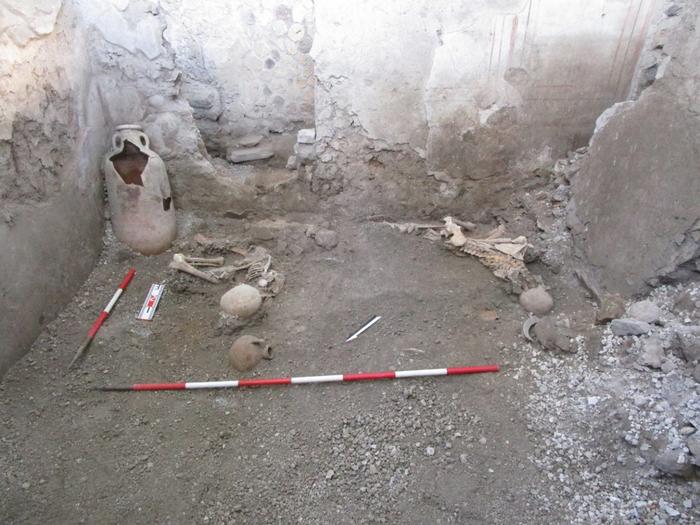Mount Vesuvius delivered a deadly one-two-three punch to Pompeii in A.D. 79. First, the volcano spewed stones high into the air, which rained down on the city. After that rock shower subsided, an earthquake shook the village. Finally, a swift river of lava, ash, and gasses — what vulcanologists call a pyroclastic flow — essentially finished off life in the village.
A new study in Frontiers in Earth Science examines the significance of that second blow —perhaps the least-understood aspect of Pompeii’s demise: the earthquake. They examined two skeletons, whose conditions on locations held some clues.
Skeletons from Pompeii
The skeletons, both from males around 50 years old, had multiple fractures and other signs of trauma.
When the researchers found two skeletons with severe fracture and trauma injuries, they were even more motivated to figure out the reason. The skeletons’ positioning suggested that the first was crushed when a wall collapsed. The second appeared to try to protect himself with a round wooden object.
Because both skeletons were found on top of the pumice lapilli — the ash and stone mix that had rained from the sky — it appears that they had survived the first phase.
There are several hints that these individuals did not die from inhaling ash or extreme heat, such as their positioning. This suggests both survived the first phase of the eruption and then were overwhelmed by collapsing walls during the earthquake before the pyroclastic flow.
Read More: Scientists Have Fully Sequenced the DNA of a Pompeii Victim for the First Time
What Happened in Pompeii?
Ancient writings indicate an earthquake’s role in the end of Pompeii. Pliny the Younger in letters described shaking ground around the time of Vesuvius’s eruption. The new findings bolster this view, says Domenico Sparice, first author of the paper a volcanologist at INGV-Osservatorio Vesuviano.
The scientists used historical accounts, other scientific studies, and the new archeological evidence to piece together a timeline. The volcano showed signs of erupting in the late morning, then really blew around 1 p.m.
“People were caught by the eruption during their every-day activities,” says Sparice.
An eruption column, tens of kilometers high, rose above the volcano and pumice lapilli, several inches wide, fell on the city for about 18 hours. The rain of lapilli pushed the inhabitants to flee or take shelter inside houses like the two individuals who took refuge in a room of a rich dwelling.
Many Pompeiians perished under collapsed roofs that were overloaded by lapilli, while others survived to this phase. After the lapilli stopped falling, some survivors likely believe that the worst was over. Then the earthquake started.
Read More: The City Under Pompeii’s Ashes, and 4 Other Sites That Civilizations Built Over
Volcano and Earthquake Destruction in Pompeii
“Some of those who did not flee their shelters were possibly overwhelmed by earthquake-induced collapses of buildings already aggravated by the load of the pumice lapilli,” says Sparice. “This was the fate of the two individuals we recovered.”
Anyone else still alive in the city was then killed by the pyroclastic flow.
“Only those who fled the city at the first signs of unrest before the eruption likely survived to the catastrophe,” says Sparice.
Teasing apart volcanic activity and earthquakes can be tricky, says Sparice. The two events can happen either simultaneously or in quick succession. By examining the layering of volcanic deposits, the ways in which buildings collapsed, and the injuries to the two skeletons, the scientists are confident they’ve reconstructed the seismic events of that tragic day.
Read More: How These 5 Ancient Cities Fell Victim to a Volcano’s Destruction
Article Sources
Our writers at Discovermagazine.com use peer-reviewed studies and high-quality sources for our articles, and our editors review for scientific accuracy and editorial standards. Review the sources used below for this article:
Frontiers. A novel view of the destruction of Pompeii during the 79 CE eruption of Vesuvius (Italy): syn-eruptive earthquakes as an additional cause of building collapse and deaths.
Before joining Discover Magazine, Paul Smaglik spent over 20 years as a science journalist, specializing in U.S. life science policy and global scientific career issues. He began his career in newspapers, but switched to scientific magazines. His work has appeared in publications including Science News, Science, Nature, and Scientific American.
>>> Read full article>>>
Copyright for syndicated content belongs to the linked Source : Discover Magazine – https://www.discovermagazine.com/the-sciences/two-skeletons-leave-behind-clues-to-pompeiis-demise
